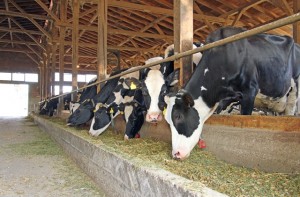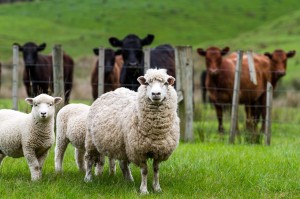Cattle Diseases
Sheep Diseases
Polioencephalomalacia of Cattle and Sheep
Also known as: Cerebrocortical Necrosis, CCN, Thiamine Deficiency, Vitamin B Deficiency, PEN
Pathologically, it is characterised by brain swelling and necrosis of the cerebral cortex, resulting from interference with the brain metabolism. This interference is associated with a deficiency of thiamine (Vitamin B1) at cell level (Rammell and Hill, 1986).
Polioencephalomalacia in sheep
Control and Prevention
Treatment Options
Good Practice
Cause of Polioencephalomalacia
Thiamine (also known as vitamin B1) is essential for glucose metabolism. Glucose is the most important form of energy for the brain and is mostly used via the glycolytic sequence and the Kreb cycle (also known as the tricarboxylic acid or citric acid cycle).
Ruminants do not depend on dietary sources for vitamin B1, as these vitamins are readily synthesised by the rumen microbes. However, in polioencephalomalacia, increased thiaminase type 1 levels are found in the rumen liquor and this enzyme not only rapidly destroys thiamine, but also leads to the production of active antagonists (molecules that get in the way of chemical processes), which further deplete the blood and tissues of thiamine.
It is commonly believed that this enzyme (thiaminase type 1) is produced in the rumen by certain bacteria, such as Clostridium sporogenes and Bacillus thiaminolyticus (Edwin et al., 1982). These organisms proliferate under conditions in which the production of volatile fatty acids is reduced, e.g. lush, low fibre forages and high concentrate diets. However, some forages, such as bracken rhizomes (Pteridium aquilinum) and Mexican fireweed (Kochia scoparia) have been implicated, as they contain thiaminase type 1. There is also evidence that treatment with certain anthelminthics (e.g. levamisole and thiabendazole) may predispose to polioencephalomalacia (Rammell and Hill, 1986) (please see the parasitic gastroenteritis page for more information on worming). Excess dietary sulphur (Haydock, 2003; Low et al., 1996; Olkowski et al., 1992; Rousseaux et al., 1991) particularly in the form of malted barley (Kul et al., 2006) and excess copper (Sargison et al., 1994) have also been associated with polioencephalomalacia.
Polioencephalomalacia in Cattle
In cattle, polioencephalomalacia is an occasional finding, but can occur in outbreaks. Animals most commonly affected are calves of 6-18 months of age. The condition has been associated with well-nourished calves that have been deprived of feed for a period due to poor pasture conditions, animals on diets with high sulphur content and animals on high concentrate rations. Whilst only a small proportion of the herd or group is affected, the affected animals are likely to die, unless treated early.
Polioencephalomalacia in Sheep
Most cases in sheep occur about 2 weeks after movement to lush pasture although it can also occur after the resumption of feeding following sheltering from severe and prolonged rainfall that may have prevented normal grazing (such an occurrence is common in SE Scotland) (Sargison, 2004). A rapid change from an all-forage to high-concentrate diet can cause CCN. This results from a shift in the bacterial populations in the rumen which can produce thiaminase (Brent and Bartley, 1984).
Control and Prevention of Polioencephalomalacia in Ruminants

High concentrate diets have been associated with polioencephalomalacia, it is therefore better to feed ruminants on high fibre diets
Low fibre forages and high concentrate diets, producing low levels of volatile fatty acids in the rumen, have been implicated in the epidemiology of polioencephalomalacia.
During an outbreak, sufficient roughage should be provided. If the problem can be associated with a high sulphur intake, all possible sources of sulphur, including water, should be analysed and the total sulphur concentration of the consumed dry matter estimated. Dietary ingredients or water with high sulphur concentration should be avoided or very gradually introduced to improve the chances of successful adaptation (The Merck Veterinary Manual, 2006).
The use of ammonium sulphate as an acidity regulator in vitamin/mineral premixes is ill-advised, as this may cause polioencephalomalacia. The inclusion of sulphur as sulphates and flowers of sulphur as copper antagonists in sheep feed may cause sulphur toxicity and hence cases of CCN, and is also not recommended (Blowey and Packington, 1994).
Treating Polioencephalomalacia
If cases do occur, in-contact animals should be supplemented with thiamine until normal rumen fermentation is re-established. Although dietary supplementation of thiamine at 3-10 mg/kg feed has been recommended for prevention, the efficacy of this approach has not been carefully evaluated (The Merck Veterinary Manual, 2006). Oral treatment with the less water soluble thiamine derivatives, such as thiamine propyl disulphide or thiamine tetrafurfuryldisulphide, is the best option, as these do not get destroyed by thiaminase and are readily absorbed from the gut (Barlow, 1991; Thomas, 1986).
If an outbreak of polioencephalomalacia occurs, in-contact animals should be supplemented with thiamine until normal rumen fermentation is re-established.
Affected individuals should be treated with high levels of thiamine HCl (10-15 mg/kg BW i.v.) or multi-B vitamin preparations (i.v.) every three to four hours until the animal has recovered. The affected animal should be isolated in a quiet, well bedded pen, with feed and water readily available. Ensure that the animal takes in fluid and does not dehydrate. Good nursing can help cases to recover. If there is no improvement, the animals should be slaughtered.
Good Practice based on Current Knowledge
- Feed a diet with at least 60% of the dry matter being fresh or conserved green forage
- Avoid feeds and water with a high sulphur content or introduce these slowly.
- Be aware of risks associated with grazing bracken
- Be aware of risks associated with animals starting grazing after a long period without or on a reduced diet (particularly following long and severe periods of rainfall)
- Do not use ammonium sulphate as an acidity regulator in vitamin/mineral premixes, if these are used on the farm. Administer thiamine HCl (10-15 mg/kg BW iv) or multi-B vitamin preparations i.v. to the affected animal every three to four hours until recovered.
- If there is no response to treatment, arrange for on-farm casualty slaughter
- Supplement in-contact animals with thiamine propyl disulphide or thiamine tetrafurfuryldisulphide until normal rumen fermentation is re-established.


 American English
American English


Comments are closed.